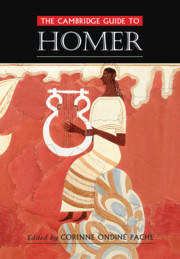Part III - Homer in the World
Published online by Cambridge University Press: 22 February 2020
- Type
- Chapter
- Information
- The Cambridge Guide to Homer , pp. 409 - 608Publisher: Cambridge University PressPrint publication year: 2020
References
Further Reading
Introduction: Surveys and Collections of Articles: Buffière 1956; Lamberton and Keaney 1992; Richardson 1993; Lamberton 1997; Hunter 2004; Graziosi 2008a; Latacz 2008; Zimmerman 2011; Dubel et al. 2015; Hunter 2018; Manolea 2019.
The Archaic Era, 650‒450 b.c.: Burkert 1987b; West 1999; Burgess 2001; Griffiths 2008.
The Classical Era, 450‒300 b.c.: Olson and Sens 1999; Halliwell 2000; Ford 2002; Graziosi 2002.
The Hellenistic Age, 300 b.c. to 14 a.d.: Sens 2005; Hutchinson 2006; Schenkeveld 2006.
The High Roman Empire, 14‒235 a.d.: Kindstrand 1973; Zeitlin 2001; Simon 2008; Kim 2010; Hardie 2011
Further Reading
Further Reading
Further Reading
Further Reading
Further Reading
The indispensable analysis of F. A. Wolf on the Homeric question, including his book’s deep roots in earlier philology and literary culture, remains the translators’ introduction to Wolf 1985. Ferreri 2007 is a colossally researched investigation of this earlier period reaching back to fifteenth-century Italy; he deals mainly though not exclusively with scholarly humanists. For Homer in more polite literary circles, the classic discussion in Simonsuuri 1979 focuses on the English Enlightenment, when an elaborate cult of Homer’s personality developed. More recently, Norman 2011 presents a convincing new account of the Quarrel of the Ancients and Moderns around 1700 in France, arguing that even Homer’s enthusiasts sometimes saw his poems as difficult or alien and that this sense of profound difference persisted into later depictions.
Further Reading
Further Reading
Further Reading
Further Reading
Further Reading
Further Reading
Further Reading
Further Reading
Further Reading
Further Reading
Further Reading
Nardi 1949; Renucci 1954; Mazzoni 1965; Pagliaro 1967, esp. 371‒432; Martellotti 1973; Fubini 1976; Padoan 1977, esp. 170‒99; Kay 1980; Ahern 1982; Barolini 1984, esp. 228‒33; Barolini 1992, esp. 41‒60 and 105‒116; Boitani 1992; Brugnoli 1993; Seriacopi 1994, esp. 155‒91; Baldelli 1998; Hollander and Hollander 2000‒2008; Brownlee 2007; Freccero 2007; Wetherbee 2008; Baranski 2010.
Further Reading
For more detailed accounts of the Homeric Question and the Analyst and Unitarian approaches to the text, see the introduction by Adam Parry to the collected works of his father Milman Parry (1971) as well as Turner 1997. On the work of Parry and Lord, its implications, and its legacy in Homeric scholarship, see the introduction by Mitchell and Nagy to the second edition of Lord [1960] 2000, Foley 1997, and Dué and Ebbott 2010. For overviews of Neoanalysis, see Clark 1986; for the relationship between orality and Neoanalysis, see Kullmann 1991, Willcock 1997, Burgess 2006, Tsagalis 2011, and Montanari 2012.



